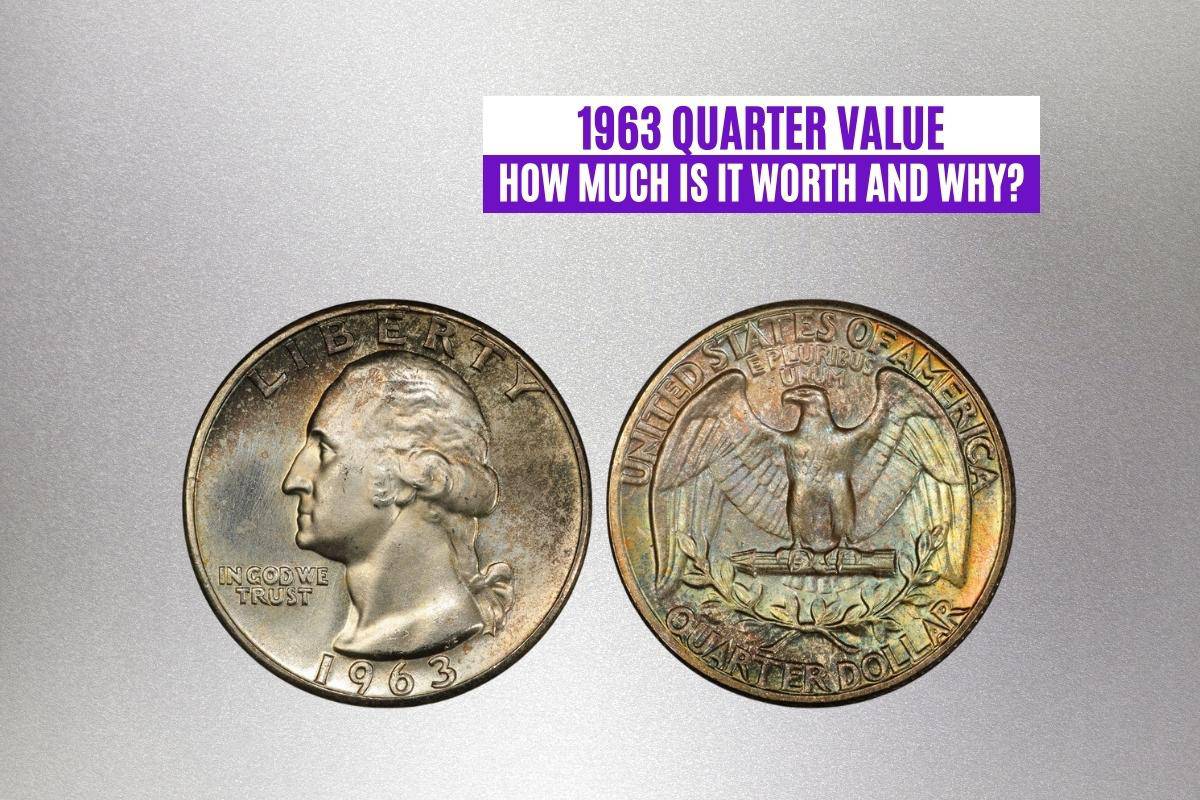Are you a coin collector (numismatist)? If so, you understand how crucial it is to keep current with coin values.
Although quarters have a listed denomination of $0.25, many are far more valuable thanks to their silver content, rarity, and age. The 1963 Washington quarter is one such coin.
This guide will explore the 1963 quarter value, revealing how much this twenty-five-cent piece is worth based on condition, mint marks, and strike type.
1963 Washington Quarter Value Chart
| Regular Strike | MS-63 | MS-65 | MS-67 |
| 1963-P Quarter | $14 | $30 | $725 |
| 1963-D Quarter | $14 | $30 | $1,050 |
| Proof Strike | PR-68 | PR-69 | PR-70 |
| 1963-P Proof Quarter | $28 | $40 | $1,700 |
| 1963-P Proof Quarter CAM | $42 | $125 | / |
| 1963-P Proof Quarter DCAM | $65 | $275 | / |
1963 Washington Quarter: History
The Washington quarter was introduced in 1932 and remained almost unchanged until 1998 (when its reverse side was changed). As a result, the 1963 Washington quarter is almost identical to the Washington quarters released before 1963.
One of the most notable aspects of the 1963 Washington quarter is its high mintage volume. While the U.S. Mint had previously established mintage records before, 1963 set a new high for quarter production, with more than 200 million being struck that year.
The U.S. Mint would outdo this record the following year, producing more than a billion quarters in 1964. So, while the 1963 Washington quarter is more common than other, older Washington quarters, it’s not quite as common as the 1964 Washington quarter.
It’s also worth noting that 1963 was one of the last years that the U.S. Mint produced quarters made of silver. The Coinage Act of 1965 eliminated the presence of silver in regular strike (for-circulation) U.S. coinage, including the Washington quarter.
1963 Washington Quarter: Design
The 1963 Washington quarter features the Washington quarter design created by American sculptor John Flanagan in 1931. The design is the longest-lived quarter design in U.S. history, lasting 66 years.
This design was based on a bust created in 1785, which George Washington actually sat and posed for. As such, the device of Washington’s face (seen on the coin’s obverse side) is considered one of the most historically accurate depictions of Washington.
However, there was a little controversy surrounding this design. It was one of the final two designs suggested for the quarter, and it initially wasn’t the leading choice.
But at the last minute, Flanagan’s Washington quarter design usurped the primary choice, a similar design created by sculptor Laura Gardin Fraser (seen in 2022 quarters).
Still, the design of the 1963 Washington quarter is virtually identical to that of all Washington quarters that came before it. The primary difference is the lack of “S” mint marks (no quarters were struck at the San Francisco Mint in 1963).
1963 Washington Quarter Obverse
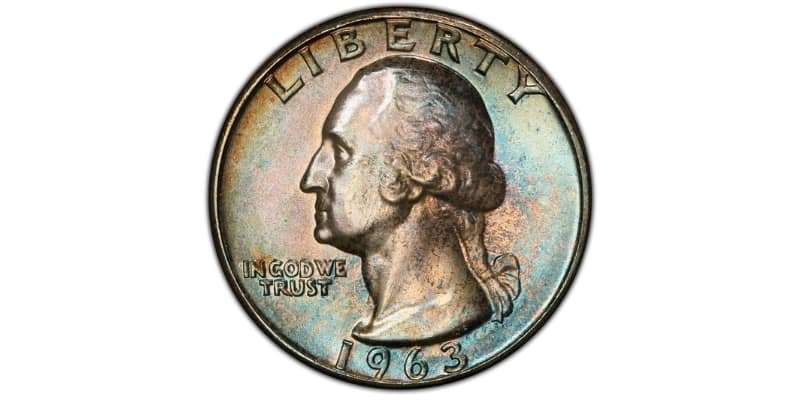
The 1963 Washington quarter has the following design elements on its obverse (front) side:
- In the center of the coin, the raised image (device) of President George Washington, face in profile, looking to the left
- At the bottom of the coin, the year date (1963)
- At the top of the coin, arching downward above Washington’s head, the legend “LIBERTY”
- In the bottom left-hand corner, the motto “IN GOD WE TRUST”
1963 Washington Quarter Reverse
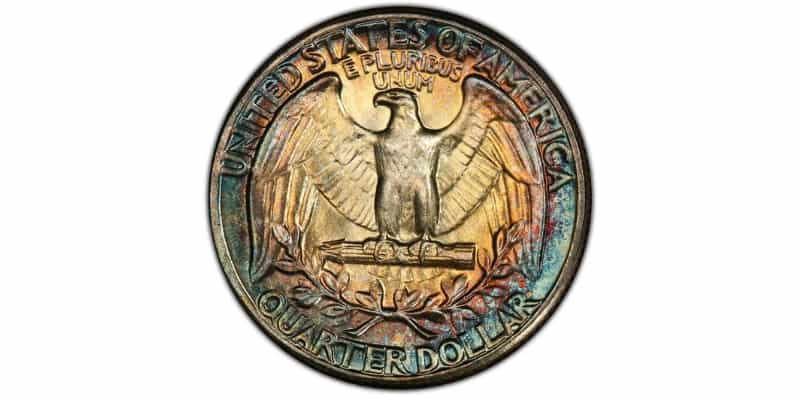
The 1963 Washington quarter has the following design elements on its reverse (back) side:
- In the center of the coin, the raised image (device) of a perched eagle above an olive branch, its arms outstretched toward the sides of the coin
- Beneath the olive branch, a mint mark (only on 1963-D Washington quarters)
- At the top of the coin, the issuing nation “UNITED STATES OF AMERICA”
- Beneath the issuing nation, the motto “E PLURIBUS UNUM”
- At the bottom of the coin, the coin denomination “QUARTER DOLLAR”
1963 Washington Quarter: Features and Specifications
1963 Washington quarters vary in a few notable ways.
For example, the proof strike 1963 Washington quarters have sharper, more distinct designs than regular strike (for-circulation) 1963 quarters (with the exception of prooflike 1963 No Mint Mark Washington quarters).
Additionally, some quarters have a “D” mint mark on their reverse sides, while others have no mint mark. Still, these coins have several shared features, regardless of their strike type and mint mark.
For example, 1963 Washington quarters:
- Have reeded (ridged) edges
- Are made of 10% copper and 90% silver
- Weigh 6.3 grams (about 0.22 ounces)
- Are 24.3 millimeters (about 0.96 inches) in diameter
But despite these similarities, 1963 Washington quarters have highly variable values influenced by factors like mint marks, coin condition, and coin strike type.
How Much Is a 1963 Washington Quarter Worth?
According to the PCGS Price Guide, a 1963-P No Mint Mark Washington quarter in circulated condition is worth approximately $6 (G-4, good condition). In about uncirculated condition (AU-50), a 1963 No Mint Mark quarter is worth about $7.
An uncirculated condition (MS-60 grade or higher) 1963-P Washington quarter is worth about $9,000 (MS-67+).
1963 Washington Quarter: Value Comparison
The U.S. Mint struck 209,604,184 Washington quarters in 1963. That’s an increase of about 22% over the previous year’s quarter production. It was also a record-setting production for quarters (although this record was broken a year later).
The 1963 Washington quarter isn’t particularly rare. Consequently, it’s less valuable than other Washington quarters, particularly those from low-production years (like 1932 and 1947).
Still, this coin’s value varies between $6 and $9,000, making it worth far more quarters struck and released today.
1963-P No Mint Mark Washington Quarter Value
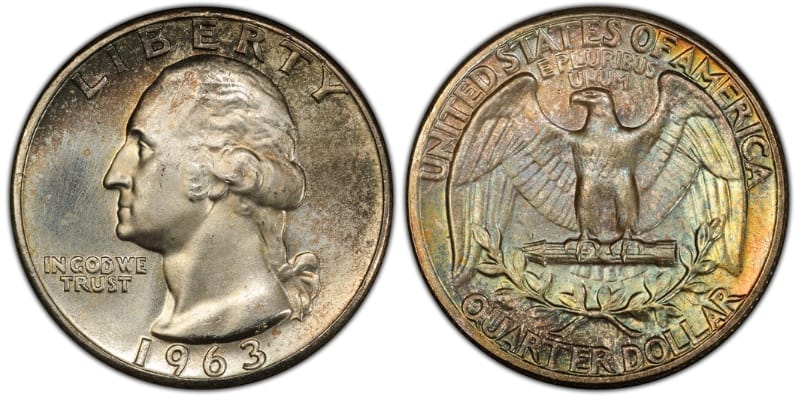
While the U.S. Mint utilized the help of several facilities to produce quarters in earlier years, only the Philadelphia Mint and Denver Mint struck Washington quarters in 1963.
The Philadelphia Mint produced fewer quarters than the Denver Mint, reaching a total production of just over 77 million (about 74 million regular strike coins and 3 million proof strike coins).
In terms of regular strike 1963 Washington quarters, those without a mint mark (those struck at the Philadelphia Mint) are the rarest.
The value of a 1963-P No Mint Mark Washington quarter starts at about $6 for good condition (G-4) pieces. It climbs slightly to $7 for 1963 No Mint Mark quarters in about uncirculated (AU-50) condition.
The most valuable 1963-P No Mint Mark Washington quarters are in uncirculated condition. An MS-60 1963 No Mint Mark quarter is worth about $10, while an MS-67+ piece is worth about $9,000.
In 2014, an MS-67+ 1963 No Mint Mark Washington quarter sold at auction for $11,163. This is the most ever spent on a 1963-P Washington quarter.
Notably, 1963-P No Mint Mark quarters are available in two varieties: circulated and prooflike.
Prooflike 1963 No Mint Mark Washington quarters were meant for circulation but don’t exhibit the common signs of wear associated with heavily circulated coins. This is likely because they were quickly removed from circulation by collectors.
Still, despite the exceptional condition of prooflike 1963-P quarters, they’re generally worth less than standard versions. A prooflike 1963-P No Mint Mark quarter with a grade of MS-66 only has an estimated value of $300.
1963-D Washington Quarter Value
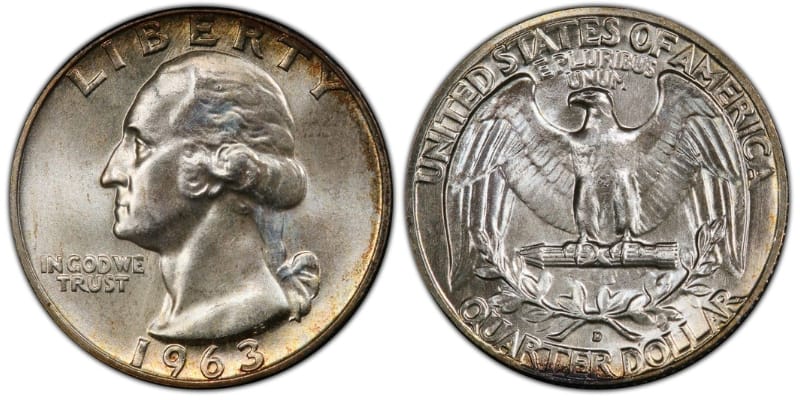
You can identify 1963-D Washington quarters by the small capital letter “D” mint mark on their reverse sides (found below the perched eagle and olive branch). In fact, 1963-D quarters are the only 1963 Washington quarters are the only quarters from 1963 that have a mint mark!
The Denver Mint produced just over 135 million Washington quarters in 1963, making 1963-D quarters more common than any other type of 1963 quarter. As you might expect, this increased commonness translates to a lower overall value, especially compared to the 1963-P No Mint Mark quarter.
The value of a 1963-D Washington quarter starts at about $6 (in good condition, G-4). In about uncirculated condition (AU-50), a 1963-D Washington quarter is worth about $7.
But in uncirculated condition (mint-state, MS-60 or higher), a 1963-D Washington quarter is worth between $10 (MS-60) and $6,250 (MS-67+).
1963-P Proof Washington Quarter Value
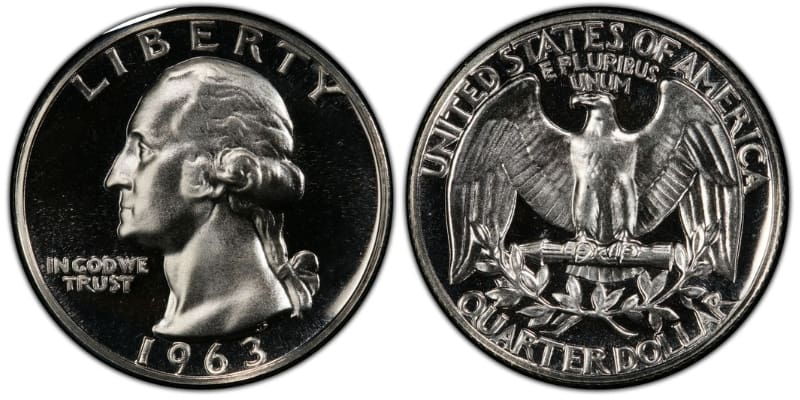
The Philadelphia Mint struck about 3.075 million proof strike coins in 1963. All of these coins were designed for collection, never entering circulation. As a result, 1963-P Proof Washington quarters almost always have a grade of PR-60 or higher.
These proof strike coins come in three types:
- Proof
- Proof cameo
- Proof deep cameo
Standard proof 1963 Washington quarters (those without a cameo effect) are worth $7 in PR-60 condition and $1,700 in PR-70 condition.
In 2014, a PR-67 proof strike 1963 Washington quarter sold at auction for $3,405.
Proof Cameo
The cameo effect on some proof coins is best described as a tonal effect. A proof coin with a cameo finish has a two-tone look, with a darker background (field) that contrasts with brighter devices (raised images and text).
A proof cameo 1963-P Washington quarter with a grade of PR-67 is worth $27. One with a grade of PR-69 is worth about $125. Overall, proof cameo 1963-P quarters are worth more than standard proof (non-cameo) quarters from the same year.
The same is true of deep cameo proof strike quarters from 1963. However, deep cameo proof quarters are generally worth slightly more than cameo ones.
Proof Deep Cameo
Deep cameo (alternatively, ultra cameo) is a more dramatic type of cameo effect. Coins with a deep cameo effect have fields (backgrounds) that are almost black and raised portions that appear silver or white.
A deep cameo 1963 proof quarter is worth $58 at PR-67+. A proof deep cameo Washington quarter from 1963 with a grade of PR-69 has an estimated worth of $275.
1963 Washington Quarter: Rare Errors
Most of the 1963 Washington quarters that entered circulation were error-free. But a few of these twenty-five-cent pieces contained mistakes, making them rare error coins that are generally worth more than non-error pieces.
Although 1963 Washington quarter error coins are uncommon, there are a few error types that collectors will want to watch for. These include the:
- 1963 Washington Quarter Wrong Planchet Type Error
- 1963 Washington Quarter Struck Through Error
- 1963 Washington Quarter Die Crack Error
1963 Washington Quarter Wrong Planchet Type Error
A planchet is a type of metal disk that forms the basis for a coin.
Each planchet has a specific metal composition that adheres to the expected metal type for a coin. For example, quarter planchets used in 1963 were 90% silver and 10% copper.
But sometimes, a mix-up leads to the wrong types of planchets ending up between quarter coin dies. This happened multiple times in 1963.
This year saw quarter designs being struck on penny and dime planchets. These “wrong planchet type” errors seem to have occurred exclusively at the Denver Mint facility, which makes sense when you consider the high volume of quarters struck at that facility during 1963.
A Washington quarter struck on the wrong planchet type can be quite valuable. For example, a quarter struck on a penny planchet sold for $1,265 when it went to auction in 2011.
So, if you own this type of 1963 Washington quarter error coin, you might have a high-value asset on your hands!
1963 Washington Quarter Struck Through Error
The struck through error is one of the easiest to recognize, as struck-through error coins typically show a smooth or blurred part of the design.
A struck through 1963 Washington quarter can sell for hundreds of dollars. For example, an MS-64 1964 No Mint Mark quarter with a copper struck through error sold for $720 in 2021.
1963 Washington Quarter Die Crack Error
Coin dies are like metal stamps, and they’re responsible for transforming blank metal planchets into recognizable coins. But while these stamp-like objects are durable, they can wear out over time.
One of the most common types of damage a coin die develops after prolonged use is cracking. Coin dies can develop hairline cracks in their recessed faces (where the design is). These cracks can get worse over time.
When a cracked coin die is pressed into a planchet, it can leave a raised line on the face of the coin caused by that crack.
The value of one of these error coins generally depends on the length and depth of the crack. More noticeable cracks tend to increase the coin’s value.
That said, these error coins aren’t the most valuable. In 2009, a die crack 1963 Washington quarter sold at auction for $16.
Frequently Asked Questions
Do you have further questions about the 1963 Washington quarter? These frequently asked questions (and their answers) offer some useful insight to help you learn more about this twenty-five-cent coin!
How Many 1963 Washington Quarters Exist?
About 20.96 million 1963 Washington quarters (regular strike) are believed to exist today, with many still in circulation. That’s about 10% of the original mintage volume (209 million).
What’s the Most Expensive 1963 Washington Quarter?
The most expensive 1963 Washington quarter is an MS-68 1963-D quarter that sold at auction for $24,000 in 2022. 1963-D Washington quarters with high grades (MS-67 or higher) are generally the most valuable 1963 quarters.
What’s the Rarest 1963 Washington Quarter?
The rarest 1963 Washington quarter is the 1963 proof strike quarter. About 3 million of these quarters were struck in 1963, but it’s believed that less than a million exist today.
1963 Quarter Value: Final Thoughts
The 1963 quarter value slowly increases over time, although time isn’t the only factor impacting the value of this Washington quarter. Mint marks and coin condition significantly influence the value of a 1963 Washington quarter.
The value of this twenty-five-cent coin varies between $6 (G-4, good condition) and $9,000 (MS-67+). The most valuable 1963 Washington quarter is the 1963-D piece in uncirculated condition (MS-67 or higher).
Learn more about high-value coins by checking out these related articles now!

